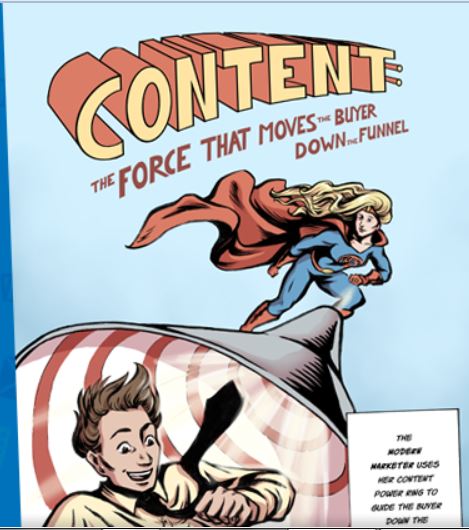Content Marketing With Research and Surveys: Pros, Cons, Examples, Best Practices
 All marketers need actionable insight to make important decisions. As the internet reaches a crescendo of voices all vying for their customers’ short attention span, the need for quality citations and third party industry research becomes even more important to stand out.
All marketers need actionable insight to make important decisions. As the internet reaches a crescendo of voices all vying for their customers’ short attention span, the need for quality citations and third party industry research becomes even more important to stand out.
Therein lies an opportunity: Companies that create credible surveys, reports and playbooks on a regular basis can become known authorities and trusted resources – ahead of the competition. Such authority leads to trust and in the content marketing world those are essential characteristics to attract a target audience whether they are buyers, journalists or investors.
Ironically, it’s this exact labor-intensive exercise that provides some of the most sharable, citable content. The ability to attract substantial citations, social shares and attention is a very powerful capability for agencies and corporate marketing marketing departments to have right now.
To benefit from this opportunity, it takes the hard work of doing thoughtful research. Once you’ve invested in conducting original, topically relevant research through polls and surveys, the task of making your findings part of the content marketing mix is only a matter of breaking it down into digestible bites, customized to the people you’re trying to connect with.
Every industry has their data champions whose purpose is to explain what’s happening in your world. Industry Analyst and Research Organizations like these devote a good portion of their marketing efforts on providing industry trends and offering insights and advice to illuminate what’s in demand within a market now and in the future:
- Altimeter Group
- Aberdeen Group
- eMarketer
- Gartner
- Forrester
- IDC
- Pew Research Center
- Nielsen Norman Group
- MarketingProfs
- Content Marketing Institute
- Econsultancy
- IAB
- CEB
Whether you’re a non-partisan, public opinion poll, a B2B company wanting to demonstrate thought leadership within the business community or a B2C brand using research to gain a foothold in a new market, the data you collect and research you conduct represent a solid foundation for a plethora of the content marketing tactics.
For example, research was recently published by The Corporate Executive Board Company and LinkedIn (a TopRank client) that identified how marketers’ content skills, in particular, need to evolve, providing any number of content bites for practitioner’s in the field.
The Interactive Advertising Bureau (IAB) has an entire section devoted to industry research available to its members that can inspire companies to conduct their own research or repurpose the research they find that relates to their audience.
When done right, you could gorge on a content feast for the next six months with the data and analysis revealed from this type research.
Pros
- Can become a revenue stream for your agency or business (MarketingProfs, eConsultancy)
- Established thought leadership in a crowded market (Gartner, Pew Research, HubSpot)
- Leverage research to drive customers and prospects to real-world events (Content Marketing World, MarketingProfs B2B Forum)
- Tacit endorsement for industry practitioners when compiled by impartial third parties (CMI, GigaOM)
- You can quantify meaningful engagement from your market research (Hubspot)
- Providing strategic industry research consistently builds your reputation, trustworthiness and, ultimately, your bottom line (CEB)
Cons
- Qualitative research takes unique skills and resources
- Direct line of sight ROI with research is not as likely compared to other content marketing metrics
- Initial research efforts, without history, may not be perceived as credible. It can take multiple reports to gain momentum.
- Your research is only as good as your premise. If your premise if flawed, your research could prove useless.
What the Marketing Experts Are Saying
“The biggest opportunity corporate researchers have is to make sure our voices are heard within the organization. Not all organizations have ‘bought in’ to research and what it can do to save time, money and resources for the future growth of a company. Researchers who know how to demonstrate this value, while also selling what they do to gain buy-in from the top down, have the greatest opportunity.” Kassandra Barnes, Research & Content Manager, CareerBuilder
“RockYou® is investing in the development of the social gaming landscape and its growth as a powerful advertising medium. This study enables us to better understand social gamers and their motivations and provide advertisers, agencies, and social game developers with actionable information they can leverage in a rapidly evolving social economy.” Julie Shumaker, SVP and GM of Media
Examples: Slide Deck, eBook, White Paper
Blackbaud & Content Marketing Institute
The Content Marketing Institute (CMI) and Blackbaud have released the findings from a first-time study that shows how nonprofit professionals in North America approach content marketing.
Getting it Right
- Piggybacking on the highly successful B2C and B2B benchmarking surveys CMI has previously conducted
- Research on how nonprofits distribute content helps justify their content marketing efforts
- Accompanied by a compelling Infographic created by Blackbaud, making the research eminently shareable across social platforms
- Offered in both PDF and slide deck creative for diverse consumer consumption
Kapost
Kapost, a content marketing software platform, developed a 41-page eBook targeted at marketers. Surprise!

Getting it Right
- Examines the new buyer’s journey and marketing’s new role
- Creative execution with its comic book theme, giving readers a unique reason to share
- Provides a side-by-side comparison of old-school vs. content-powered marketing
- Suveryed content marketing industry experts, such as Joe Pulizzi (Content Marketing Institute), Joe Chernov (Kinvey), Barabara Saxby (Accelent Consulting), Todd Wheatland (Kelly OCG) to derive recommended next steps
Jive
Social business solutions technology provider, Jive, partnered with GigOm, a new type of media company, to identify how HR can embrace social business despite a distributed enterprise workforce.

Getting it Right
- White paper explores the current state of the workforce
- Partnering with independent third party, GigaOM Research, lends credibility to the research
- Presenting research on social technology investments for HR give a reason to share the data across social platforms.
Photo credit: GigaOM
Guidelines for Conducting Customer Surveys & Research for Content Marketing
For the purposes of our online marketing audience, the following guidelines apply to conducting electronic surveys only.
- Conduct preliminary research – With automated survey software you can create multiple surveys to gather information. Start with questions that will give you actionable information. Your goals will determine what those questions should be.
- Determine your target audience – Customize your survey for your target group. If you’ve been segmenting your email list based on the minimum customer profile of existing, potential and leads. The language and tone may vary depending on where someone is in the customer life cycle.
- Keep the questions simple – Use simple straightforward language and keep them as short as possible. Avoid asking two pieces of information in one question, e.g. cost and quality. Break it into two shore simple questions, leading to better data.
- Prioritize question order – Start with personal questions that the respondent would most likely respond to from their own experience and work your way toward least-personalized questions once the respondent has warmed up.
- Use ample white space – If you’re using free online survey software, pay particular attention to the layout. Ideally, you want a survey that presents each question on its own individual page, taking advantage of the white space. It helps to have a progress bar, so respondents know where they are in the process and don’t feel overwhelmed by a long list of questions.
- Be transparent – Be honest with exactly how long the survey will take. I’ve exited out of surveys when I saw that the progress bar didn’t match my expectation for time allotted.
- Test before sending – Obviously, you want to check for spelling and grammar errors, but testing different email platforms is important as well. Send a survey to a small sample of your target audience. Feedback from the testers can provide invaluable insight, such as confusing questions illogical order and so on.
For a more detailed understanding of internet methodology, please see Conducting Research on the Internet: Online Survey Design, Development and Implementation Guidelines at ResearchGate.net.
Does your organization use surveys or conduct research to create more insightful content for your audience?
If you like in-depth articles like this about content marketing, be sure to visit our index of content marketing tactics.
Photo credit: Shutterstock
![]()
Gain a competitive advantage by subscribing to the
TopRank® Online Marketing Newsletter.
© Online Marketing Blog, 2014. |
Content Marketing With Research and Surveys: Pros, Cons, Examples, Best Practices | http://www.toprankblog.com

You must be logged in to post a comment.